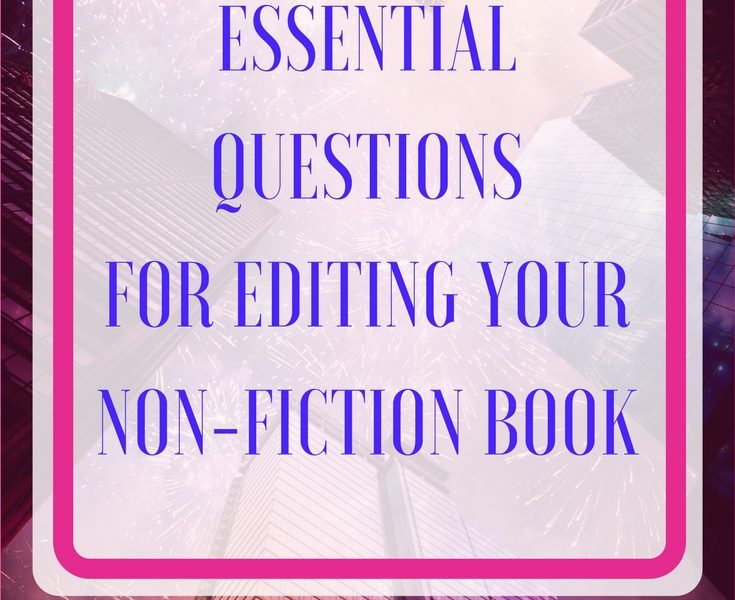Pulling together the culmination of your research? Writing your story to inspire others to achieve as you have? Once you’re done, you’ll need to run a thorough edit before you can publish, so this is the best spot for you to start!
Non-fiction is a breeze, right? You don’t have to come up with the plot. Just type about your experience or your research, and you’re set. Eh, not so much.
Non-fiction is a completely different beast from fiction to edit, and though you likely don’t have to worry as much about coming up with a way to link all the threads, you still have to make sure it happened.
This week and next, I’m discussing some questions to ask yourself when you edit your non-fiction work to make sure that your audience has the best experience possible.
Pattern
Many non-fiction books follow a pattern per chapter. Maybe you open with a quote or an anecdote and then continue with the information. Maybe you did your chapter by topic and set up subsections that match in each section to discuss the basics, the effects, and the actions the reader should take. Maybe you use a pattern of phrasing to intro and conclude each chapter. Whatever your pattern is, one of the first things to check when you edit is if you stick to the pattern.
Developing a pattern for your book makes readers feel comfortable, much like how children like rhyming books. They know what pattern to expect. Disrupting that pattern will leave your reader hanging, and it looks unprofessional.
Ask yourself:
- Do I follow a pattern for my chapters? (Or should I adjust it so I do?)
- Did I use the same pattern for all the chapters?
Promise
Your readers have an expectation when they read your book, whether it’s based on the back cover text, an ad you placed for it on Facebook, or the recommendation of a friend. You can control two of those, so consider carefully what to tell your reader.
Make sure that your reader is getting what they expect. Match the promise on the back of the book and in any ads you place to what the book is actually doing. If your description on the back of the book promises actionable steps to achieve a goal, it needs to be more than just great copy. Does the book actually do what you claim? If you are looking around the room a little uncomfortable right now and saying, “Well, it could lead to that. . .” then rethink your promise.
Did you set out to achieve a certain goal with this book? Then make sure that you met it. If you are educating me on the healthiest way to lose ten pounds in two weeks, then your promise should be obvious throughout the book. Either rethink the goal or adjust the text to ensure that you met your promise.
Consider whether you cover everything that your reader actually needs to know to get those results. Ask yourself:
- Do I answer questions that need to be addressed?
- Do I provide enough information to benefit the reader?
- Did I give them what I promised?
Overlap
Although this should have been a major focus in the planning stages of your book, you might have gotten a little muddy in the writing. No matter, that’s what a good, brutal edit is for!
We sometimes go off on tangents when we write, so it’s possible that you talked a little about the same subtopic in a couple chapters. If it’s just a reference to let the reader know that you will discuss it in depth in a later chapter, don’t worry about it, but repeating information really isn’t necessary.
As you edit to tighten up the writing, ask yourself:
- Does each chapter cover a specific topic that doesn’t overlap with another chapter?
Clarity
Sometimes this is the toughest part of editing. Stepping outside of our own heads can be incredibly hard, so you may find yourself fighting on this one.
Especially if you are providing instructions, you have to ensure that everything is clear to the audience who will be reading it. Check on jargon. Make sure that you haven’t glossed over details. You might even discuss the instruction with someone of the same level of understanding as your audience to ensure that you haven’t missed something and aren’t talking over their heads.
Also, be sure that you connect your thoughts expertly, without throwing them together and hoping that the reader will get the connection themselves. Paragraphs should flow seamlessly without stopping and starting like a toddler throwing a tantrum.
Sure, you understand what you mean, but you have to step back and ask:
- Do I clearly complete a point before moving on to the next?
Pattern, promise, overlap, and clarity are pretty basic steps to take when reviewing non-fiction, but they should set your brain on the path of thinking critically about your writing. This post is by no means a comprehensive list . . . and I challenge anyone to come up with a list of every, single persnickety detail that you have to analyze while editing.
Check in next week for info about sweetening the experience by connecting with your readers through your text and additional related materials. Especially writers of inspiring books will want to tune in for this one!

